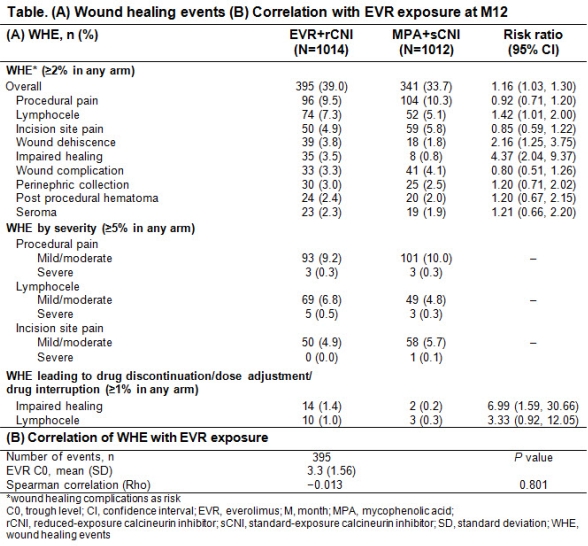Effect of De Novo Use of Everolimus with Reduced Calcineurin Inhibitor versus Standard Mycophenolic Acid-Based Regimen on Wound Healing Events in Kidney Transplant Recipients from TRANSFORM Study
TRANSFORM Study Group, Novartis Pharma AG, Basel, Switzerland.
Meeting: 2018 American Transplant Congress
Abstract number: C67
Keywords: Kidney transplantation, Surgical complications
Session Information
Session Name: Poster Session C: Kidney Immunosuppression: Novel Regimens and Drug Minimization
Session Type: Poster Session
Date: Monday, June 4, 2018
Session Time: 6:00pm-7:00pm
 Presentation Time: 6:00pm-7:00pm
Presentation Time: 6:00pm-7:00pm
Location: Hall 4EF
Purpose: Anti-proliferative properties of mammalian target of rapamycin inhibitors (mTORi) may affect the wound healing process and there are some reservations about including mTORi into immunosuppressive regimen immediately after transplantation (Tx). Here, we evaluate the effect of de novo use of everolimus (EVR) in combination with reduced-exposure calcineurin inhibitor (rCNI) vs MPA with standard-exposure CNI (sCNI) on wound healing events (WHE) from TRANSFORM, the largest trial to date.
Methods: In this 24-month (M), multicenter, open-label study, de novo adult kidney transplant recipients were randomized to receive either EVR+rCNI (N=1022; EVR trough level [C0]: 3-8 ng/mL; tacrolimus [TAC] C0: 4-7, 2-5, 2-4 ng/mL; cyclosporine A [CsA] C0: 100-150, 50-100, 25-50 ng/mL) or MPA+sCNI (N=1015; MPA: 1.44 g/day of enteric-coated mycophenolate sodium or 2 g/day of mycophenolate mofetil; TAC C0: 8-12, 6-10, 5-8 ng/mL; CsA C0: 200-300, 150-200, 100-200 ng/mL from Day1-M2, M3-M6, and M7-M24, respectively), with basiliximab/rabbit antithymocyte globulin induction+steroids. The WHE and their association with EVR exposure at M12 are summarized.
Results: Overall, baseline characteristics including mean body mass index (25.6 kg/m2 in both arms) and incidence of diabetes (EVR+rCNI vs MPA+sCNI: 27.3% vs 26.5%) were comparable between the arms. Up to 86% of patients were within the target EVR C0 over 12 months. The overall incidence of WHE was comparable between both arms. Procedural pain, lymphocele, and incision site pain were the most common WHE in both arms and were majorly of mild to moderate severity. Significant higher incidence of wound dehiscence (3.8% vs 1.8%) and impaired healing (3.5% vs 0.8%) was reported in the EVR+rCNI vs MPA+sCNI arms. No correlation was noted between WHE and EVR C0 at M12 (Table).
Conclusion: In spite of EVR initiation within 24 hours of Tx, the increased risk of WHE was limited between the EVR+rCNI and MPA+sCNI arms and the EVR C0 did not affect the incidence of WHE at M12.
CITATION INFORMATION: Henry M., Citterio F., Kim M., Kim D., Bernhardt P., Gupta A., Watarai Y. Effect of De Novo Use of Everolimus with Reduced Calcineurin Inhibitor versus Standard Mycophenolic Acid-Based Regimen on Wound Healing Events in Kidney Transplant Recipients from TRANSFORM Study Am J Transplant. 2017;17 (suppl 3).
To cite this abstract in AMA style:
Henry M, Citterio F, Kim M, Kim D, Bernhardt P, Gupta A, Watarai Y. Effect of De Novo Use of Everolimus with Reduced Calcineurin Inhibitor versus Standard Mycophenolic Acid-Based Regimen on Wound Healing Events in Kidney Transplant Recipients from TRANSFORM Study [abstract]. https://atcmeetingabstracts.com/abstract/effect-of-de-novo-use-of-everolimus-with-reduced-calcineurin-inhibitor-versus-standard-mycophenolic-acid-based-regimen-on-wound-healing-events-in-kidney-transplant-recipients-from-transform-study/. Accessed January 7, 2026.« Back to 2018 American Transplant Congress

